 | |||
|
| Home > Public Information > ING Annual Reports > 2002-2003 > Chapter 3. Use of Observing Time and Scientific Productivity |
 | |||
|
| Home > Public Information > ING Annual Reports > 2002-2003 > Chapter 3. Use of Observing Time and Scientific Productivity |
Other available formats: PDF
Chapter 3| WHT | INT | JKT |
||||
| Time Allocation | 2002 | 2003 | 2002 | 2003 | 2002 | 2003 |
|---|---|---|---|---|---|---|
| UK PATT | 156 | 159 | 125 | 134 | 175 | 90 |
| NL PC | 43 | 52 | 34 | 45 | 46 | 29 |
| SP CAT | 76 | 93 | 85 | 101 | 83 | 54 |
| UK/NL WFS | — | — | 60 | 50 | — | — |
| ITP | 10 | — | 17 | — | 16 | — |
| Service | 33 | 21 | 25 | 9 | 13 | — |
| Instrument Builder’s Guaranteed Time | 4 | — | — | — | — | — |
| Discretionary | 43 | 40 | 19 | 26 | 32 | 8 |
| Total | 365 | 365 | 365 | 365 | 365 | 181 |
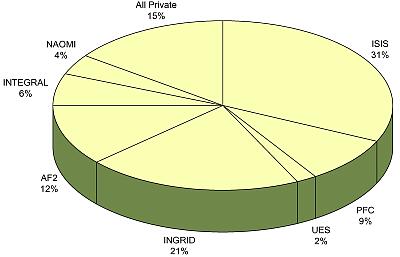
|
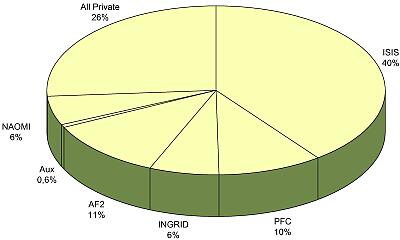
|
| Figure 1. Left: Use of instrumentation
in semesters 2002A and 2002B on the WHT. All private includes ULTRACAM, PN.S
and SAURON. [ JPEG | TIFF ]
Below: The same for semesters 2003A and 2003B. Commissioning nights are excluded.
All private includes ULTRACAM, SAURON, PN.S, INTEGRAL, CIRPASS. [ JPEG | TIFF ] |
|

|
| Figure 2. Technical downtime per semester. [
JPEG | TIFF ] |
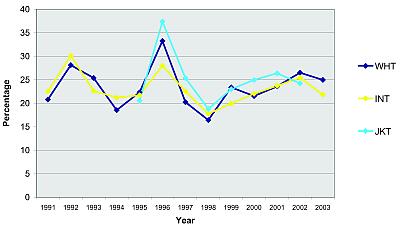
|
| Figure 3. Weather downtime per year. [ JPEG | TIFF ] |
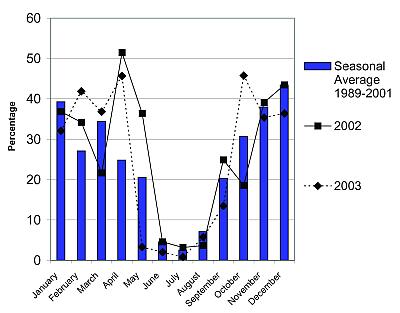
|
| Figure 4. WHT monthly weather downtime. [ JPEG | TIFF ] |
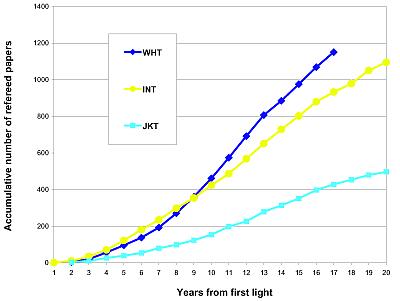
|
| Figure 5. Accumulative number of refereed papers
per telescope from first light. [ JPEG | TIFF ] |
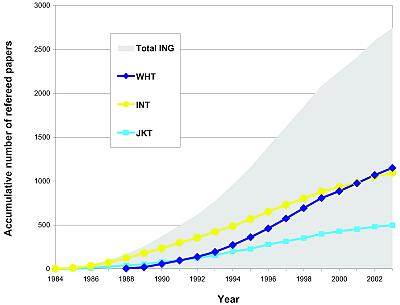
|
| Figure 6. Accumulative number of refereed papers
per year. [ JPEG | TIFF
] |
| Year | WHT | INT | JKT | Total |
|---|---|---|---|---|
| 1984 | — | 1 | — | 1 |
| 1985 | — | 10 | 3 | 13 |
| 1986 | — | 24 | 8 | 32 |
| 1987 | — | 36 | 16 | 52 |
| 1988 | 5 | 52 | 12 | 69 |
| 1989 | 15 | 58 | 15 | 88 |
| 1990 | 37 | 54 | 26 | 117 |
| 1991 | 39 | 63 | 19 | 121 |
| 1992 | 42 | 56 | 25 | 123 |
| 1993 | 55 | 70 | 30 | 155 |
| 1994 | 78 | 63 | 44 | 185 |
| 1995 | 90 | 81 | 29 | 200 |
| 1996 | 100 | 84 | 52 | 236 |
| 1997 | 113 | 77 | 35 | 225 |
| 1998 | 118 | 72 | 38 | 228 |
| 1999 | 115 | 78 | 46 | 239 |
| 2000 | 78 | 53 | 31 | 162 |
| 2001 | 91 | 46 | 25 | 162 |
| 2002 | 93 | 72 | 26 | 191 |
| 2003 | 82 | 44 | 17 | 143 |
| Total | 1151 | 1094 | 497 | 2742 |
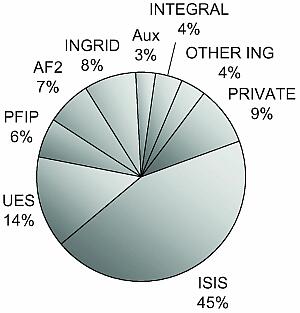
|
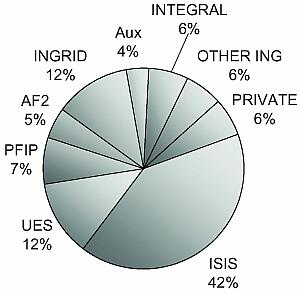
|
| Figure 7. Use of instrument data in
WHT papers in 2002 (left) [ JPEG | TIFF ] and 2003 (right) [ JPEG
| TIFF ]. |
|
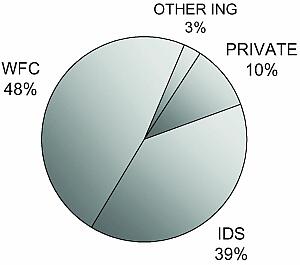
|
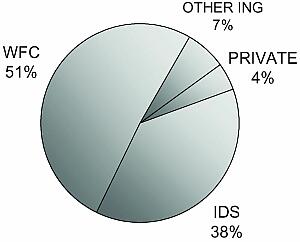
|
| Figure 8. Use of instrument data in
INT papers in 2002 (left) [ JPEG | TIFF ] and 2003 (right) [ JPEG
| TIFF ]. |
|

|
| Figure 9. ING’s paper authorship. [ JPEG | TIFF ] |

|
| Figure 10. Number of ING archive requests. [ JPEG | TIFF ] |